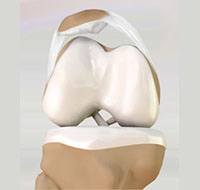Lateral Patellar Compression Syndrome

What is Lateral Patellar Compression Syndrome?
Lateral patellar compression syndrome refers to pain under and around your kneecap. It is a common complaint among runners, jumpers, and other athletes such as skiers, cyclists and soccer players.
The patella, also called kneecap, is a small flat triangular bone located at the front of the knee joint. It is a sesamoid bone embedded in a tendon that connects the muscles of the thigh to the shinbone (tibia). The function of the patella is to protect the front part of the knee.
Causes of Lateral Patellar Compression Syndrome
Lateral patellar compression syndrome can result from poor alignment of the kneecap, complete or partial dislocation, overuse, tight or weak thigh muscles, flat feet and direct trauma to the knee.
Symptoms of Lateral Patellar Compression Syndrome
Pain is the predominant symptom and is usually gradual in onset. Patients may experience a dull aching pain around the sides, below or behind the kneecap. Sometimes, climbing stairs and standing up or walking after prolonged sitting may produce a popping or cracking sound in the knee. The pain may also be present at night and be exaggerated by any repetitive knee bending activity such as jumping, squatting, running or weight lifting.
Diagnosis of Lateral Patellar Compression Syndrome
To diagnose lateral patellar compression syndrome, your doctor will ask about your symptoms, medical history, any sports participation, and activities that aggravate your knee pain. Your doctor will perform a physical examination of your knee. Diagnostic imaging tests such as X-rays, MRIs and CT scans may be ordered to check if your pain is due to damage to the structure of the knee or because of the tissues that attach to it.
Treatment of Lateral Patellar Compression Syndrome
The first treatment step is to avoid activities such as running and jumping, that cause pain. Treatment options include both non-surgical and surgical methods. Non-surgical treatment consists of rest, ice, compression, and elevation (RICE protocol); all assist in controlling pain and swelling. Non-steroidal anti-inflammatory medications may be prescribed to reduce pain.
Exercises: Your doctor may recommend an exercise program to improve the flexibility and strength of thigh muscles. Cross-training exercises to stretch the lower extremities may also be recommended by your doctor.
Other non-surgical treatments include:
- Knee taping: An adhesive tape is applied over the patella, to alter the kneecap alignment and movement. Taping of the patella may reduce pain.
- Knee brace: A special brace for the knee may be used during sports participation which may help reduce pain.
If symptoms persist, a lateral retinacular release may be performed. In this procedure, the tight ligaments on the outer side of the knee are released, thus allowing the patella to sit properly in the femoral groove. Your surgeon may also tighten the tendons on the inside or medial side of the knee to realign the quadriceps.







